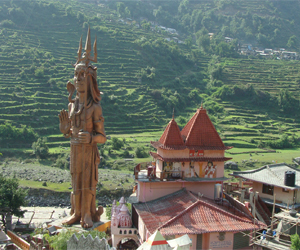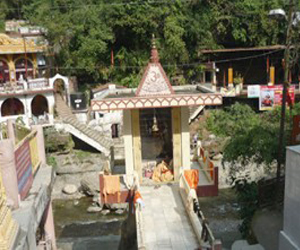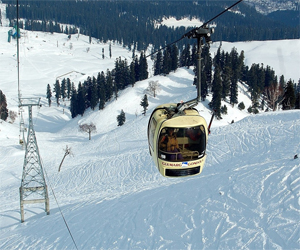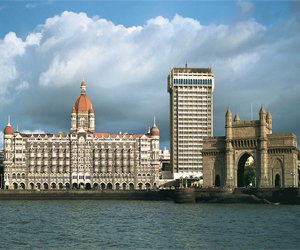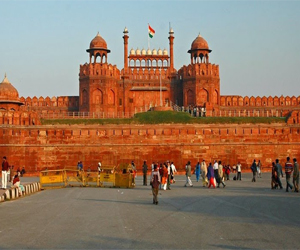The ageless beauty of Gulmarg reflects the purity of nature. This small yet magnificent town is haven for the adventure seekers and a paradise for nature lovers. Toddle along the vast stretches of flower-clad meadows and sway through the alpine mountains replete with snow. Gulmarg invokes adventure instincts and at the same time offers a refreshing ambiance to retain peace of mind- it is a perfect melange to savour the taste of real Kashmir.
The ‘Heartland of Winter sports’, Gulmarg is where all the excitement takes place. The very first ski resort was established here in 1927 and ever since Gulmarg has been an epitome of skiing in the country. The town also takes great pride in owning Asia’s largest and world’s second largest cable car project called Gulmarg Gondola. It connects Gulmarg with Aparwath Mountain, from where one can ski down on a long snow-trail. Shark Fin is another brilliant place for powder skiing in the town. Gulmarg also boasts about being the longest Golf Course in India. Set against a beautiful backdrop, it attracts a large number of visitors.
The picturesque landscape offers myriad of options for sightseeing in Gulmarg. Places like Kongdori and Aparwath are well-connected through the Gulmarg Gondola. Scenic, as they can best be described, these fascinating places offer a panoramic view of the valley. Khilanmarg is another spectacular destination situated in the vicinity of Gulmarg offering unmatched view of the Himalayan range. A frozen lake situated 13 kms beyond Khilanmarg also attracts attention as a popular tourist attraction in Gulmarg. The virgin terrains of Nagin Valley and the sacred shrine of Baba Reshi sanctify this serene valley. The undying spectacle called Gulmarg gives millions of reasons to travellers across the globe to throng here.
Mumbai is the capital of Maharashtra and the economic powerhouse India. It’s an exhilarating city, fuelled by entrepreneurial energy, determination and dreams. Compared to the torpor of the rest of India, it can seem like a foreign country. Mumbai is the finance capital of the nation, the industrial hub of everything from textiles to petrochemicals, and it’s responsible for half the country’s foreign trade. To many visitors, Mumbai is the glamour of Bollywood cinema, cricket on the maidans on weekends, bhelpuri on the beach at Chowpatty and red double-decker buses. While it boasts an impressive Victoria townscape, a sculptured island cave temple and a national park that’s roamed by wild tigers, the city’s formal attractions pale in comparison to the nonstop theater of its streets. Sixteen million people from all over India are wedged into Mumbai and after a short stroll you will feel like you have rubbed shoulders with and bumped into every single one of them. The size of the population means the city has enough social problems to last a lifetime, but its spirit is irrepressible and it has personality by the bucket load. As the cultural bridgehead between east and west, whatever happens in the rest of India tends to happens first in Mumbai, and it usually happens with the maximum amount of swank and noise. Most visitors to India gear themselves up to confront poverty, but it’s the extravagant display of wealth in Mumbai that seem shocking. In many parts of the city flash cars and mobile phones are as common as street kids or beggars, and Mumbai loves to claim it has more millionaires than Manhattan. Flush with money, the city has an established social elite and an entertainment hungry middle class, which mean diversions are never in short supply. Mumbai lives and breathes cinema, enjoy a rollicking nightlife, boasts the best seafood restaurants in South Asia and has more shops and bazaars than you could ever hope to explore.
History
The seven islands that now form Mumbai were first home to the Koli fisher folk, whose shanties still occupy parts of the city shoreline today. The island were ruled by a succession of Hindu dynasties, invaded by Muslim in the 14th century and then ceded to Portugal by the Sultan of Gujarat in 1534. The Portuguese did little to develop them before the major island of the group was included in Catherine of Braganza’s dowry when she married England’s Charles II in 1661. The British Government took possession of all seven islands in 1665 but leased them three years later to the East India Company for a meagre annual rent. Bombay soon develop as a trading port, thanks to its fine harbour and because merchants were attracted from other parts of India by the British promise of religious freedom and land grants. Bombay’s fort was built in 1720s, and land reclamation projects soon began the century-long process of joining the seven islands into a single land mass. Although Bombay grew steadily during the 18th century, it remained isolated from its hinterland until the British defeated the Marathas and annexed substantial portions of Western India in 1818. Growth was spurred by the arrival of steam ships and the construction of the first railway in Asia from Bombay to Thane in 1853. Bombay played a formative role in the struggle for Independence, hosting the first Indian National Congress in 1885 and the launched of the ‘Quit India’ campaign in 1942. After Independence the city became capital of the Bombay Presidency, but this was divided on linguistic grounds into Maharashtra and gujarat in 1960. Since then Bombay was made the capital of Maharashtra, the city of Bombay was officially renamed Mumbai in 1996.
Climate
Mumbai is warm and humid year round, and temperatures are stable thanks to the moderating influence of the sea. There are three distinct seasons: summer, monsoon and what is quaintly referred to as winter. Summer lasts from March to mid-June and is characterized by high temperatures, sticky humidity and short tempers. There’s a slight drop in temperature when the monsoon arrives from the south in mid-June and proceeds to dump 2000mm of rain on the city over next three months. It generally rains everyday, during the monsoon, but it certainly doesn’t rain all the time. There’s then a short transition to winter, which begins in earnest in mid-October and lasts until late February. Winter means an average 2°C drop in temperature, clear skies and fractionally lower humidity -anywhere else in the world.
Population
15 million.
Main Language
Marathi, Hindi, English.
Telephone Area Code
022
Best Time to Go
September to April.
Delhi, one of India’s fastest growing cities, has spread far beyond the “seven cities” created between the 13th and the 17th centuries. It has sprawled over the west bank of the Yamuna and now straddles the river. Remnants of the past survive cheek-by-jowl with skyscrapers, residential colonies and bustling commercial complexes. Delhi has some of the finest museums in the country. Its boutiques and shopping arcades offer access to a wealth of traditional and contemporary crafts from all over the country. It has speciality restaurants to please the gourmet, open parks and gardens ablaze with flowers, and in the winter months particularly, a variety of cultural events. Its many-layered existence is tantalizing and can entice the curious traveller into a fascinating journey of discovery.
The history of this centre of power dates to the first millennium BC. In 1955 excavations within the Purana Qila revealed that the area was inhabited more than 3000 years ago. This was Indraprastha, a site associated with the epic Mahabharata. A clearer picture emerges at the end of the 10th century. The Tomar Rajputs built Lal Kot, the core of the first of Delhi’s seven cities. Later, another Rajput king, Prithviraj Chauhan — hero of ballads and legends —extended it to create the Qila Rai Pitbora. In 1206, Qutb ud din Aibak, aslave of Mohammad of Ghor crowned himself the Sultan of Delhi and occupied the Rajput fort. He commemorated his victory by building the Quwwat ul Islammosque. It is the earliest extant mosque in India and within its courtyard stands the 4th-century standard of Lord Vishnu, the famous, uncorroded Iron Pillar. Nearby, he raised the towering minaret, the Qutub Minar, one of Delhi’s landmarks. Other architectural gems within this complex include the tomb of Iltutmish and the Alai Darwaza.
Around 1311, Allaudin Khilji established Siri, the second city and dug a vast reservoir at Hauz Khas. Very little remains of Siri, but Hauz Khas was extensively renovated a few decades later. Now, ethnic boutiques and cafes dot the Hauz Khas village and the location is as attractive as the exclusive goods on sale.
The great fort of Tughlaqabad was raised in 1321 as a protection against Mongol raids and became Delhi’s third city. The fort and tomb are characteristic of robust Tughlaq architecture. Delhi’s fourth city, Jahanpanah has practically disappeared but its fifth, Firoz Shah Kotla rises off Bahadur Shah Zafar Marg and is well known for its Ashokan pillar which the Sultan brought from Mathura. Timur devastated Delhi in 1398 and as a result the 15th century saw little growth. The tombs of the Lodi kings date to this era and are within the landscaped Lodi Gardens, one of Delhi’s most beautiful gardens.
In 1526, Babur founded the Mughal empire in India. The impressive Purana Qila, Delhi’s sixth city, is a combined effort of his son Humayun and the Afghan Sher Shah Suri who temporarily deposed him. The fort contains a fine mosque and what was possibly a library. Nearby are the Zoo, the Crafts Museum, where craftsmen work in a simulated rural setting, andPragati Maidan, the exhibition grounds. The magnificent tomb of Humayun, which is a precursor to the Taj Mahal is 2 km from here.
In April 1639 the Mughal emperor Shah Jahan laid the foundation of Shahjahanabad, Delhi’s seventh city, and it epitomised the grandeur of his empire. This walled city has since been continuously inhabited. It is one of the most densely populated localities in the world and it retains a unique vitality and charm. The Red Fort, Shah Jahan’s sandstone citadel encompasses grand audience halls — where the legendary Peacock Throne once stood — and marble palaces ornamented with exquisite pietra dura. Opposite the Red Fort is the Jama Masjid, India’s largest mosque.
For the intrepid traveller there is rnore… Chandni Chowk, the moonlit square, is adjacent to the mosque, and leads to the heart of the walled city. This was once a tree-lined bazaar with a canal flowing through its centre. Today, it is one of the largest trading centres in northern India – thriving, congested and chaotic. Chandni Chowk is replete with historical landmarks and each of its bylanes leads into a world of spices or silver or perfumes or textiles…..
New Delhi was built in 1911. It was tobe “conceived with spaciousness and care so that the new creation would be in every way worthy of this ancient and beautiful city”. Lutyens and Baker planned a city with wide, tree-lined avenues. The 340-roomed Viceregal Lodge, now the Rashtrapati Bhawan, was raised on Raisina Hill. Nearby are India Gate, a World War I memorial. Parliament House, the prestigious National Museum and the National Gallery of Modern Art. On Republic Day, Rajpath witnesses a display of pageantry.
The classy commercial centre of Connaught Place was planned as part of New Delhi. Alongwith stalls on Janpath, and emporia on Baba Kharak Singh Marg, it is a shopper’s paradise. Rather characteristically, an 18th century masonry observatory, the Jantar Mantar, lies in the midst of this commercial area.
But there is still more to Delhi Art galleries and theatres and a variety of museums… memorials to leaders… Hindu, Sikh, Buddhist, Jain and Bahai temples- folk dancers, discotheques, urban villages – even birdwatching along the ridge. Come discover a country through a city,
ADDED ATTRACTIONS (Rates on request)
Visit to Village Bistro, Hauz Khas for a cultural extravaganza, followed by dinner at an authentic village complex, comprising shops and restaurants.
Meeting with astrologer, who can forecast what your future could be. With near-to-accurate predictions, these astrologers can answer your many questions of anxiety.
Sound and light show at the Red Fort narrating the rich history of the Red Fort and the ruling dynasties of Delhi until the independence of India.
ACCESSIBILITY: As a major entry point for India many major international flights go through New Delhi. It is also extensively connected by air, road and rail with the rest of the country.
BEST SEASON: October to March
WHAT TO WEAR: Cottons in summer, woolens in winter.dgfgfd

